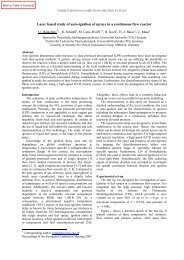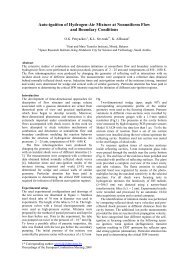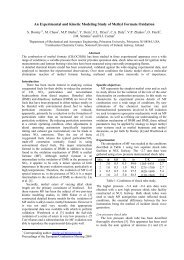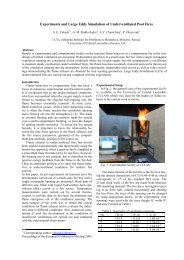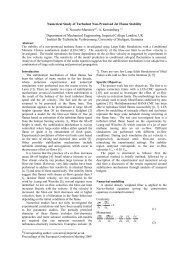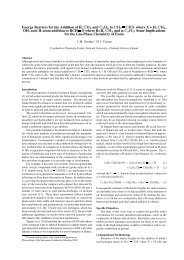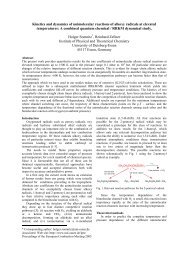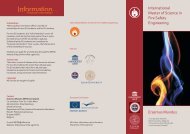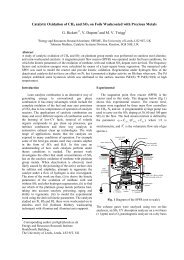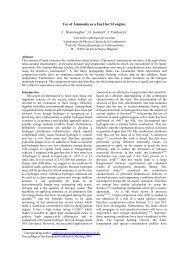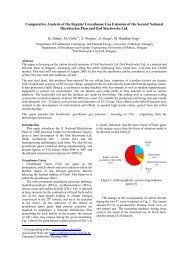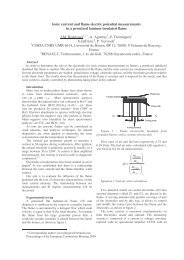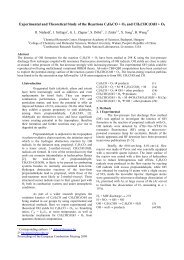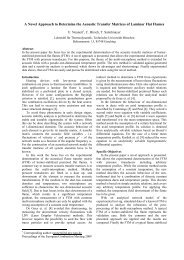Investigation of Two-Photon Laser-Induced Fluorescence Detection ...
Investigation of Two-Photon Laser-Induced Fluorescence Detection ...
Investigation of Two-Photon Laser-Induced Fluorescence Detection ...
Create successful ePaper yourself
Turn your PDF publications into a flip-book with our unique Google optimized e-Paper software.
dependent on several parameters, like laser intensity,<br />
ionization, non-linear absorption which all contribute<br />
to the question <strong>of</strong> correct signal interpretation in an<br />
applied combustion situation. In order to understand<br />
the phenomena taking place and the interaction<br />
between these phenomena a simulation based on a<br />
four level rate equation system including photoionisation,<br />
quenching, two-photon absorption, and<br />
spontaneous emission was applied to calculate the<br />
spatial distribution <strong>of</strong> the CO LIF signal [22]. The<br />
thick line shown in Figure 3 is a simulation <strong>of</strong> the<br />
measured curves with 2.4 mJ per pulse the laser<br />
intensity. A general similarity between the simulated<br />
pr<strong>of</strong>ile and the measured one was achieved, which<br />
indicates that the model are proper in prescribe the<br />
observed the phenomenon.<br />
Figure 3. The variation <strong>of</strong> the CO LIF intensity along<br />
the laser beam. The gas pressure <strong>of</strong> CO in the cell was<br />
held constant at 400 mbar, while the energy <strong>of</strong> the laser<br />
pulse was varied from 0.2 to 2.4 mJ. The thick line<br />
represents a simulated fluorescence signal along the<br />
laser beam with 2.4 mJ per pulse.<br />
Signal intensity (counts)<br />
10 4<br />
10 3<br />
k = 2<br />
k = 1<br />
0.1 bar<br />
0.2 bar<br />
0.5 bar<br />
1.0 bar<br />
2.0 bar<br />
3.0 bar<br />
106 107 108 109 <strong>Laser</strong> fluence (W/cm2) Figure 4. Plot showing the measured LIF<br />
signal vs excitation laser fluxes at different CO<br />
pressures.<br />
Shown in Figure 4 are the LIF signal intensities<br />
as the laser energy was increased for different<br />
pressures <strong>of</strong> CO in the cell. Normally, the<br />
3<br />
fluorescence signal, S, in a two-photon excitation<br />
processes depends quadratically on the incident laser<br />
intensity, I, i.e. S ∼ I k , where k = 2. However, at<br />
higher laser energies photo-ionization <strong>of</strong> the CO<br />
molecule becomes significant. Moreover, the<br />
transition starts to saturate and also at higher laser<br />
energy two-photon absorption decreases the signal<br />
intensity. Hence, the fluorescence signal scales with k<br />
= 2 in the low laser intensity limit, and turns into k is<br />
close to one when the laser intensity is increased. If<br />
the laser intensity is further increased the signal goes<br />
through a maximum until the signal actually<br />
decreases as the laser intensity is increased further.<br />
Figure 5. LIF signal dependence on the buffer N2 pressures (100 mbar CO, N2 pressure varied).<br />
In order to estimate the delectability <strong>of</strong> using<br />
two-photon LIF at elevated pressure, e.g. in engines,<br />
measurements in the cell with and without buffer<br />
gases were carried out at pressures from 0.1 bar up to<br />
8 bar. It is more realistic to investigate the CO LIF<br />
signal intensity while adding a buffer gas to a<br />
constant pressure <strong>of</strong> CO in the cell. Shown in Figure<br />
5 is the signal distribution from CO at a pressure <strong>of</strong><br />
100 mbar while the pressure <strong>of</strong> the buffer gas, N2,<br />
was varied from 0 to 10 bar. As expected the signal<br />
decreases as the pressure is increased. Also the shape<br />
<strong>of</strong> the signal distribution changes as the pressure<br />
increases.<br />
In the flame investigations, the behaviour <strong>of</strong><br />
spectral interference from non-resonantly excited C2<br />
molecules, produced by photo-decomposition <strong>of</strong> fuel<br />
and fuel fragments, were studied at various<br />
stoichiometries and laser intensities. The first flame<br />
measurement was performed in a laminar, premixed,<br />
methane/air flame. During the flame measurements<br />
the cell was replaced by a premixed Bunsen-type<br />
conical burner, which has a prolonged intake duct in<br />
order to assure a laminar flow. Through a<br />
spectrometer (Acton, SpectraPro-150) equipped the<br />
ICCD camera, a spectral resolved CO LIF spectrum,<br />
as shown in Figure 6, was recorded for a Φ = 1.5<br />
methane/air flame with 50 laser shots averaged. As<br />
shown in the Figure, some C2 interference lines are<br />
clearly shown.



